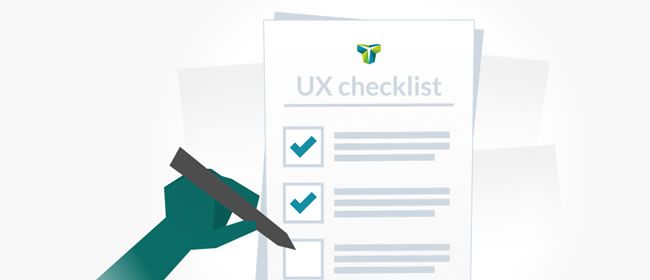Radikally Different - Our World View

A Must Have Checklist for UX Designers
Have you often ended your UX quest with a question like “Is this the best I can provide”? If yes then you must have a checklist to follow up. Eliminating idea blocks and gaps in design consistencies is the way to a successful UX design action. Treating it as cooking will make the process easier. Consider estimation, evaluation, preparation, competitor analysis, documentation, mobile assessment, SEO, reviews, analytics, style guide, mockups, testing, etc as the ingredients for your meal. By having a checklist you choose keep the process simplified and stay focused on your work.

Points We Define as Checklist for UX Designers
- Overall analysis of the Project.
- Review and research of user insights from all sources.
- Identify research needs.
- Review high level requirements.
- Formulate a brief design structure representing initial design elements to be implemented in the UX.
- Review personas.
Why Do You Need a Checklist?
- It becomes easier to manage and maintain design concepts. Peer reviews are easier to post and assess. Whether you share a word document or a poster or project management tools team work becomes smooth.
- Expectations and Engagement must be included in the checklist for UX designers. A design project does not include just design tasks. It is important to know how you set expectations i.e. how you interact with customers. An engagement section will include important touch points with your clients.
- Having a simple checklist does not mean you have a simple task in hand. It simplifies the process of checking and doing the right things by staying focused.
- Creative people find a proper structure to continue focusing on right design processes. The checklist forms a solid foundation for work. Teamwork and efforts become glorified.
- Visibility is incorporated. By checking off items from the checklist an increased visibility is ensured in the team.
- Flexibility is brought up. A design checklist becomes a solid guide. With activities being included right approaches and activities are selected according to the project needs. Redundant and unnecessary items can be put off the list. Everything is put on the right track for a project.
Necessary Areas to be Included in the Checklist for UX Designers
Homepage –
- First Impression or First Impact must project positivity which is followed by conversion.
- Contact information or company details must be available on the homepage. It should also be easily to find by the user.
- Clear call to action lets a user to know what tasks to perform next and what are its benefits. Purpose of a website must be clear to them.
- A privacy policy must be included in case a website in interested to gather user information.
User Experience –
- Web pages must not refresh automatically. Users get irritated with fresh content getting uploaded suddenly.
- Pricing must be clearly displayed. Hidden costs or surprise are undesirable.
- User registration adds value to users. However care must be taken to avoid unnecessary registration.
- Real information like images of company owners, employees or location, references and contact details must be showcased.
- A website must be professionally designed and up-to-date.
- Users must be able to perform detailed viewing of services and products. Scan-worthy information and easy zooming images must be included.
- Personalized features such as location, language, taxes, country-specific deals, currency and delivery options must be available in a website. IP-based geo-location must not be included without getting a user’s permission.
Search –
- Large sized websites must include search bars.
- Search fields must be wide for users to see what is being typed.
- Search should be a form not a link.
- Search option must be available for all pages.
Navigation –
- Sitemap must be included for large websites.
- Significant links must not have moving features. Auto-rotating accordions or carousels arte not good.
- A website must have an easy remembering URL.
- Consistent navigation in every page is important.
- Every site description and links must be easy to understand and descriptive.
Links –
- Uniform colour must be presented in a website. It must also be noted that visited links must be different from unvisited links.
- Commands must be presented in buttons and not as links.
- Broken must not be present.
- Clickable links must look like clickable items. They must be easily recognised by a user.
Read Also: Design Your Website to Engage Users
Accessibility –
- A website can be navigated with a keyboard. User must be able to find things in the website without a mouse. Browser’s shortcuts must not be overridden.
- Images and maps must have alt attributes. Videos and audios must also have descriptions or captions.
- Checkbox, links and buttons must be easily clickable. Texts in checkbox fields when clicked must be selected. Checkboxes only must not be select-worthy.
- Content and colour must blend well so that it is easier for users to read content.
Content –
- Content must be lucidly written keeping in mind the common man’s understanding.
- Background colour and text must be in contrast.
- Content must be relevant and up-to-date. Users must be able to pose common questions and receive easy answers to their queries.
- Content must be easily scanned. There must be short paragraphs, points with proper visuals and headings.
- Prose text must avoid Uppercase letters.
- Company information or contact details must be clear. Users clicking on contact must not find an automatic mail application opening.
Layout –
- Well categorized information must be presented.
- Clear display of relevant information.
- Important content must be prioritized in display.
- Clutter in any form must be avoided.
- Responsive websites works in different sizes.
- Pop-ups must be avoided or minimum use of pop-ups providing only important info must be presented.
- Layout for all pages must be consistent.
Forms –
- Confirmation page for form submission must be there.
- Necessary questions only must be asked in the forms.
- Field labels must have common terms like address, location, name, etc.
- Field labels must also have auto fill options.
- Long drop down menus must be avoided. Long scrolls irritate users.
Errors –
- A website must be compatible with various browsers.
- SSL certification must be present in a website.
- A site must have custom error pages like 404 and 500.
- Testing with target users must be performed in real-time.
By following these instructions you are ensured of having an improved website UX design. However, testing, user reviews, peer reviews and feedbacks are important in gathering speed and solidarity in website building. A must have checklist for UX designers is as important as having the website as a whole.
- Augmented Reality (4)
- Enterprise (9)
- Games (15)
- Marketing (17)
- Mobile App Development (26)
- Mobile Apps (19)
- Mobility Solutions (1)
- Monetization (8)
- News (16)
- Remote Hiring (1)
- Strategy (13)
- Testing (7)
- Uncategorized (1)
- User Experience (8)
- Virtual Reality (4)
- Web Browsing (1)
- Web Design & Development (20)